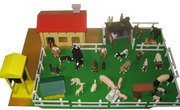In “The Monkey’s Paw,” a short story published in 1902 by W.W. Jacobs, the White family comes to possess a magical artifact, a monkey’s paw that can grant its owners three wishes. Of course, there is a catch. Any wish granted by the monkey’s paw comes with dire consequences. The moral of the Monkey’s Paw, as you may have guessed, is be careful what you wish for.
The Moral of “The Monkey’s Paw”
Beyond “be careful what you wish for,” the moral of “The Monkey’s Paw” digs deeper into the reader’s psyche. The White family has everything they could need, but they lose their happiness and security because they want too much. So another moral of “The Monkey’s Paw” is to appreciate what you have and avoid the temptations of greed.
“The Monkey’s Paw” Lesson Plan Ideas
Reading “The Monkey’s Paw” is an effective way to teach several higher-level literary devices, such as foreshadowing and irony. “The Monkey’s Paw” lesson plan ideas will incorporate critical reading skills like making inferences because irony has to be inferred in the story’s context.
Example lesson: Ask students to read the text aloud as a group. As they read, students should use context clues to understand the meaning of words in context. Students should write down words they don’t know and look up the words later in the lesson. After reading, students should answer text-dependent questions, so the teacher can measure their reading comprehension. For deeper analysis, students can write an extended response answer that assesses the moral lesson of the story through its use of situational irony. Teachers should grade these responses on a rubric to normalize assessment criteria. Other “The Monkey’s Paw” lesson plan ideas should include more hands-on activities.
“The Monkey’s Paw” Activities
After students have read the story for understanding, “The Monkey’s Paw” activities can help them better interact with the ideas of the story. “The Monkey’s Paw” activities can include storytelling and group work, and they should work to assess either the story’s major theme or its higher level literary devices. The best “The Monkey’s Paw” activities will do all of these things.
Example activity: Ask students to get into groups of three. They’re going to tell each other spooky stories with a twist. Give each student a piece of construction paper and colored pencils or other art supplies. Tell the students to decide as a group what their magic wishing object will be. Each student should draw their own version of the object.
Separately, the students should each write something they would wish for at the top of their page. Tell the students their object is cursed like the monkey’s paw. They will get what they wish for — for a price. Each student should write the curse that comes with their wish at the bottom of the page. Using situational irony, students should match the curse with the wish so that it’s obvious they should have been more careful what they wished for. Students should illustrate their wishes and curses then return to their trio to relate their spooky stories to their group.
Related Articles
References
Writer Bio
Rebecca Renner is a teacher and freelance writer from Daytona Beach, Florida. Her byline has appeared in the Washington Post, New York Magazine, Glamour and elsewhere.











